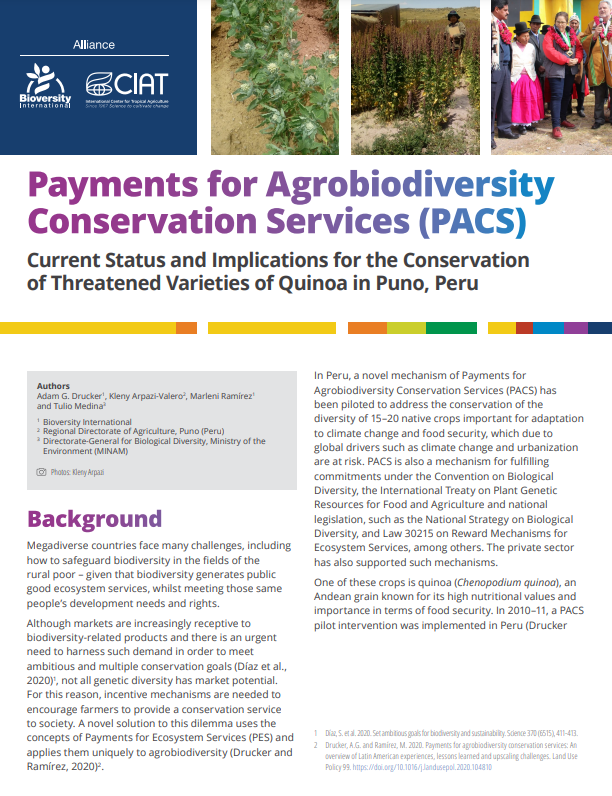Megadiverse countries face many challenges, including how to safeguard biodiversity in the fields of the rural poor – given that biodiversity generates public good ecosystem services, whilst meeting those same people’s development needs and rights. Although markets are increasingly receptive to biodiversity-related products and there is an urgent need to harness such demand in order to meet ambitious and multiple conservation goals (Díaz et al., 2020), not all genetic diversity has market potential.
For this reason, incentive mechanisms are needed to encourage farmers to provide a conservation service to society. A novel solution to this dilemma uses the concepts of Payments for Ecosystem Services (PES) and applies them uniquely to agrobiodiversity (Drucker and Ramírez, 2020).
In Peru, a novel mechanism of Payments for Agrobiodiversity Conservation Services (PACS) has been piloted to address the conservation of the diversity of 15–20 native crops important for adaptation to climate change and food security, which due to global drivers such as climate change and urbanization are at risk.
PACS is also a mechanism for fulfilling commitments under the Convention on Biological Diversity, the International Treaty on Plant Genetic Resources for Food and Agriculture and national legislation, such as the National Strategy on Biological Diversity, and Law 30215 on Reward Mechanisms for Ecosystem Services, among others. The private sector has also supported such mechanisms.
One of these crops is quinoa (Chenopodium quinoa), an Andean grain known for its high nutritional values and importance in terms of food security. In 2010–11, a PACS pilot intervention was implemented in Peru (Drucker and Ramírez, 2020; Narloch et al., 2011a, 2011b)3. […]
Six community organizations located in the Provinces of Lampa, San Román, Azangaro, El Collao and Chucuito4 were selected through a competitive tender process, involving 41 farmers (of which 45% were women) in conservation activities related to four threatened quinoa varieties and covering a total of 1.45 hectares.
Here we present the results of a second follow-up and monitoring visit, conducted in December 2020 in order to identify the degree of persistence of quinoa in the farmers’ fields in the absence of any further external incentives.
We explore farmers’ reasons for not continuing to plant these varieties and the implications for future interventions seeking to increase the in situ population of these quinoa varieties to a level considered “not at risk.
Drucker, Adam; Arpazi-Valero, Kleny; Ramirez, Marleni; Medina, Tulio.

